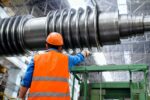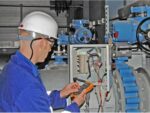Construction workers often prefer to wear vented hard hats because they are cooler, but often ask if vented hard hats are OSHA approved.
OSHA do indeed approve many of the vented hard hats, in particular for outdoor work, but have strict regulations with vents for indoor work, in particular when electrics are involved.

Why construction workers like vented hats?
Even in winter, construction work can get hot. Construction work is hard labour and so, sun or rain, workers often break out in a sweat. It is for this reason that vented hard hats are popular. Heat builds up and when it has nowhere to escape to, it gets hotter. When there is a vent, the heat can get out, allowing the air to cool down.
Many of the hard hats on the market have vents
Many hard hats have vents allowing hot air can escape. Because construction work is generally hard, workers do get hot. Vents in a hard hat cool down the person wearing the hat.
This is really helpful, especially when working outdoors under the hot sun, or in any extreme work conditions. Vents allow the wearer to ‘breathe’.
Pros of a vented hard hat:-
-
-
- Release the build up of heat
- Increase circulation
- Offer comfort to the worker.
-
Cons of a vented hard hat:-
-
-
- No protection against electrical shocks.
-
Whilst there is only one con against a vented hard hat, it is a huge negative. Construction workers who are working with, or close to electricity, must have protection in case of surges or shock. A vented hard hat does not offer protection against electrical problems.
Recommended OSHA approved vented hats
As with any hard hat that is purchased, you need to always check:-
-
-
- If the hard hat is OSHA approved
- If the manufacturer has followed all the OSHA guidelines.
- If the hat is safe for electrical work.
- The type and class of the hard hat.
-
- Vented to reduce inside helmet temperatures
- Meets ANSI/ISEA Z89.1-2009, type I, class C requirements
- High-density polyethylene (HDPE) shell with a full brim providing additional protection against sun, glare, rain and falling debris
- 6 point suspension system with polyester textile straps offers unrivaled comfort without compromising performance
- Unique 3D adjustment provides a precise fit using harness depth settings
- Hat Size: 6 5/8 - 8 (20 7/8 - 25)
Prices pulled from the Amazon Product Advertising API on:
Product prices and availability are accurate as of the date/time indicated and are subject to change. Any price and availability information displayed on [relevant Amazon Site(s), as applicable] at the time of purchase will apply to the purchase of this product.
What Accessories to buy for OHSA approved Vented Hats
When you buy an OSHA approved hard hat, it is generally going to come with the:-
-
-
- Hard hat shell. (brim, peak, or plain)
- Suspension or ratchet. (4, 6 or 8 ratchet)
- Chin strap.
- Sweatband
-
Optional accessories include:
-
-
- Headlamp
- Visor
- Sweatbands (you can buy extra)
- Chinstraps (you can buy extra)
- A beanie for underneath. (for warmth or a tighter fit)
- Sunshades or hard hat flaps.
-
The sweatband on a hard hat (which is helpful in the best of times, but especially in the hard hats without vents) can be bought in bulk and changed on a regular basis.
Sweatbands are a necessity in all hard hats used in construction work, but are an extra necessity in those hard hats without vents.
Headlamps, as accessories, for any hard hat, can be simple to give a little light, or hugely powerful, depending on the job that is going to be done. A Headlamp can make the job even hotter, so check if your hard hat is vented, or if it can be vented.
For all construction workers, wearing a hard hat in the heat can be difficult. Yes, the vented hats make a huge difference but one can also add a had hat flap to protect from the sun and heat.
Some of the OSHA approved vented Hard Hats include:-
-
-
- Acerpal
- J. Keller, Safegear
- Evolution Deluxe
- Ergodyne
-
While it is clear that vented hard hats are going to be more comfortable and practical in the heat, vented hard hats can not always be used. This is for because the vented hard hats do not offer electrical insulation protection.
You need to choose your hard hat carefully, and ensure that you, or your workers, are wearing the right PPE. Hard hats should be OSHA approved.
Are there OSHA hard hat exemptions?
When you walk into a construction site, there is one sign that is always clear.
-
-
- Please wear your hard hat.
- Construction workers must wear hard hats.
- Visitors to site must wear hard hats.
- Do not forget your hard hat.
-
Some people may be exempt by OSHA, perhaps on the grounds of religion or for person reasons, BUT – the person who is exempt does so under his or her own risk.
While OSHA is the regulating body for Occupational Safety and Health, some hard hats fall under different regulators. It is up to you to double check that the hard hats you are using fall under strict manufacturer guidelines provided by OSHA.
Are cowboy hard hats OSHA approved
Many workers like to wear cowboy hard hats, although not necessarily for construction work. A cowboy hard hat does offer certain protection and some are OSHA approved.
They are excellent for outdoor work, perhaps even on the back of a horse. Or while rounding up cattle. They do deflect blows to the head, but mostly to the top of the head and not the side.
- 6-Point Ratchet Suspension
- Durable outer shell constructed on high density polyethylene
- Deflects Blows to the head
- Reduces danger from exposure to low and high voltage electrical conductors
- Complies with ANSI Z89.1, Type 1, Class E, G, & C
Prices pulled from the Amazon Product Advertising API on:
Product prices and availability are accurate as of the date/time indicated and are subject to change. Any price and availability information displayed on [relevant Amazon Site(s), as applicable] at the time of purchase will apply to the purchase of this product.
The above cowboy hard hat does come with a suspension or ratchet system, but you should always check if the cowboy hard hat is OSHA approved.
Cowboy hard hats can be cooler to wear than the hard hats with brims or peaks, but may not be as protective. It all depends on the job that needs to get done, and how much risk there is. A cowboy hard hat is called a cowboy hat for a reason – they are great for cowboys.
Most cowboy hard hats are not vented, as the style of the hat allows for good side ventilation anyway. This also means the sides of the head are not protected in case of an accident.
There is choice for hard hats, with or without vents, on the market
When looking to buy hard hats:-
-
-
- Check if the hard hats are OSHA approved.
- Look at the different types styles of hard hats on the market, Type 1 or Type 2.
- Check the class of the hard hat, which will tell you about protection and safety.
- Look at the vents and check the electrical safety options too
- Remember you can buy accessories, such as chin straps, sweat bands, sun flaps, visors and headlamps.
- Inspect the hard hat on a regular basis for damage.
- Replace chin straps once they start to fray or before they lose their elasticity.
- Safety is the most important aspect of work! Your safety and your team’s safety.
-







